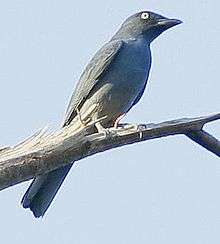Bar-bellied cuckooshrike
| Bar-bellied cuckooshrike | |
|---|---|
 | |
| Mount Makiling, Philippines | |
| Scientific classification | |
| Kingdom: | Animalia |
| Phylum: | Chordata |
| Class: | Aves |
| Order: | Passeriformes |
| Family: | Campephagidae |
| Genus: | Coracina |
| Species: | C. striata |
| Binomial name | |
| Coracina striata (Boddaert, 1783) | |
The bar-bellied cuckooshrike (Coracina striata) is a species of bird in the family Campephagidae. It is found in Thailand, Malaysia, Indonesia, and the Philippines, and its natural habitats include mangrove forest, dry forest, swamp forest, and secondary forest. The plumage varies among the subspecies, with different amounts of barring on the underparts. The International Union for Conservation of Nature (IUCN) has assessed the species as one of least-concern.
Taxonomy
Pieter Boddaert gave this species the scientific name Corvus striatus in 1783, in a table of Edme-Louis Daubenton's illustrations for the Histoire Naturelle.[2] It was erroneously[3] thought to be a crow from New Guinea.[2] It was then variously placed in the genera Graucalus and Artamides[4] until Coracina was widely accepted around the early 1940s.[5] The IOC World Bird List recognises fourteen extant subspecies: Coracina striata sumatrensis, C. s. simalurensis, C. s. babiensis, C. s. kannegieteri, C. s. enganensis, C. s. bungurensis, C. s. vordemani, C. s. difficilis, C. s. striata, C. s. mindorensis, C. s. panayensis, C. s. boholensis, C. s. kochii and C. s. guillemardi.[6] C. s. cebuensis, formerly found on Cebu, is extinct.[7] The Andaman cuckooshrike (Coracina dobsoni) is sometimes considered a subspecies. The Handbook of the Birds of the World considers panayensis to be a separate species.[3]
Description
The bar-bellied cuckooshrike is 24–32 cm (9.4–12.6 in) long. The plumage and size are variable.[3] In the Philippines, the subspecies guillemardi and mindorensis are uniformly grey, with some black on the male's head; in striata, cebuensis, and difficilis, the male has faint barring on the rump, and the female's belly is barred black and white; in panayensis, the male also has black and white bars on the belly, and the female has additional barred patches on the breast; in kochii, the male's breast is also barred, and the female's underparts are entirely barred.[8][9] In C. s. sumatrensis of the Thai-Malay Peninsula, Sumatra and Borneo, the male has grey upperparts with some barring on the rump and lower-tail coverts, and the female's underparts are barred up to the lower breast.[10][11] The juvenile bird has grey upperparts and entirely barred underparts in panayensis and kochii;[8] in sumatrensis, the juvenile has brown, white and black upperparts, and the underparts are white with black bars.[10]
Distribution and habitat
This cuckooshrike is found in the Thai-Malay Peninsula, Sumatra, Borneo, the Philippines, and many small islands in the area, such as the Kangean Islands and Natuna Islands. It became locally extinct in Singapore around the late 1960s.[10] It lives at low elevations, its habitats being back-mangrove forest, dry forest, freshwater swamp forest,[11] secondary forest, and sometimes scrubs and plantations.[10]
Behaviour
This cuckooshrike usually lives in small groups or in mixed-species foraging flocks with other cuckooshrikes.[7] It mainly eats insects, including caterpillars, mantids, and dragonflies, and also feeds on figs.[10] Vocalisations include a harsh klee kleep,[7] a whistling keeuk-keeuk, sic sic sic, tliu k'liu and a whinnying kliukliukliu.[10] Breeding has been reported in April and May. The cup nest is built on the fork of a tree and is made of mosses, lichens, leaves, rootlets[7], and possibly mud.[10] The eggs are grey, marked lavender, and reddish brown.[7]
Status
This species has a large range. Its global population appears to be decreasing because of habitat destruction, but not rapidly, so the IUCN Red List has assessed it as a least-concern species.[1] In the Thai-Malay Peninsula, it is considered to be vulnerable.[10]
References
- 1 2 BirdLife International (2017). "Coracina striata". IUCN Red List of Threatened Species. IUCN. 2017: e.T103694198A112322247. doi:10.2305/IUCN.UK.2017-1.RLTS.T103694198A112322247.en. Retrieved 29 May 2018.
- 1 2 Boddaert, Pieter (1783). Table des planches enluminéez d'histoire naturelle de M. D'Aubenton (in French). p. 38.
- 1 2 3 Taylor, B.; Kirwan, G. M. "Bar-bellied cuckooshrike (Coracina striata)". In del Hoyo, J.; Elliott, A.; Sargatal, J.; Christie, D. A.; de Juana, E. Handbook of the Birds of the World Alive. Lynx Edicions. Retrieved June 18, 2018.
- ↑ McGregor, Richard C. (1909). A manual of Philippine birds. p. 482.
- ↑ Ripley, S. Dillon (1941). "Notes on the Genus Coracina" (PDF). The Auk. 58: 381–395.
- ↑ Gill, F.; Donsker, D. (eds.). "Bristlehead, butcherbirds, woodswallows, ioras, cuckooshrikes". IOC World Bird List Version 8.1. Retrieved 29 May 2018.
- 1 2 3 4 5 Kennedy, Robert S.; Gonzales, Pedro C.; Dickinson, Edward C.; Miranda, Hector C. Jr; Fisher, Timothy H. (2000). A Guide to the Birds of the Philippines. Oxford University Press. p. 225. ISBN 9780198546689.
- 1 2 Ripley, S. Dillon; Rabor, D. S. (1958). "Notes on a Collection of Birds from Mindoro Island, Philippines". Bulletin (Peabody Museum of Natural History) (13): 55–56.
- ↑ du Pont, John E. (1971). Philippine birds. Delaware Museum of Natural History. pp. 234–235.
- 1 2 3 4 5 6 7 8 Wells, David R. (2010). The Birds of the Thai-Malay Peninsula. 2. Bloomsbury. pp. 84–86. ISBN 9781408133132.
- 1 2 Robson, Craig (2015). Birds of South-East Asia (Concise ed.). Bloomsbury. p. 172. ISBN 9781472924254.
